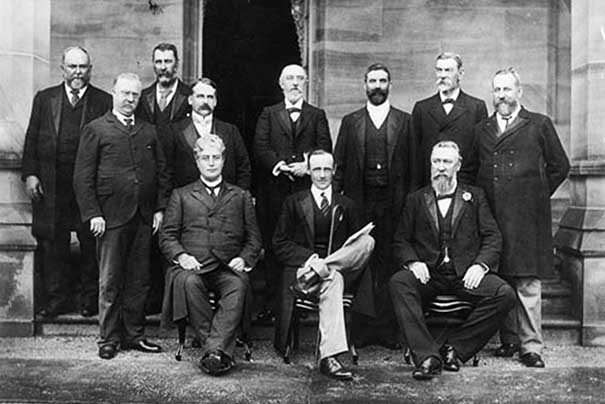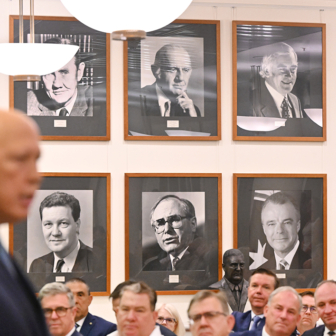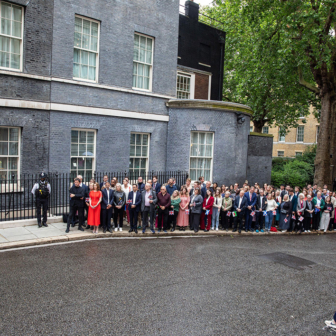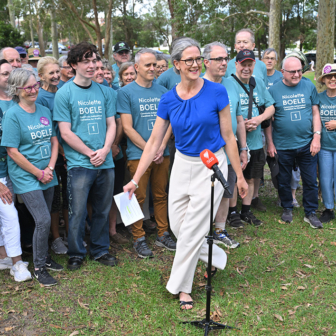In his latest book, The Break-Up of Australia: The Real Agenda Behind Aboriginal Recognition, Keith Windschuttle makes a case against recognising Aboriginal people in the Constitution. Most other public advocacy has been in support of the Yes case, with political leaders from both sides of politics treating it as a priority. But there is no consensus on how it might be done, and the issue has been complicated by demands from Indigenous groups that a treaty or treaties with Indigenous people must be part of, or precede, such recognition. Windschuttle, by contrast, claims that “there is a rational and well-founded case to be made in answer to the arguments in support of constitutional change.”
To make the No case, Windschuttle rehearses positions he took in The Fabrication of Aboriginal History and other books. He attacks leading proponents of Aboriginal recognition, charging them with misrepresenting the Constitution as racist and promoting an exaggerated view of Aboriginal culture as distinct from that of mainstream Australia. His thesis that the break-up of Australia is a deliberate purpose or unforeseen consequence of the constitutional recognition of Indigenous people is exaggerated, however, and his historical and constitutional scholarship selective and partial in key aspects.
None more so than his claim that the Franchise Act 1902 did not deny the vote to Aborigines after federation. Quite the contrary, he contends: most Aborigines were not precluded from voting; rather, section 41 of the Constitution guaranteed their vote. If Windschuttle is right, then the generally accepted view that the Franchise Act denied Aboriginal people the right to vote is wrong. Windschuttle is aggressive in damning his opponents. Their claim that, in his words, “The Commonwealth Franchise Act 1902 denied the vote to Aborigines after Federation,” is one of fifteen “worst myths” that “Aboriginal supporters, especially those employed by our university law schools, have grown so audacious” in inventing. They have concocted “a contrived case of conspicuous compassion for political ends,” he claims.
Invective aside, Windschuttle does make a robust defence of the Constitution as a non-racist, liberal-democratic instrument of government. His analysis of the few sections of the Constitution that mention “Aboriginal natives” or race, and his overall assessment of the Constitution as non-racist, are painstakingly researched and correctly argued. Those who drafted the Constitution were not conservative racists but mainly progressive liberals, including Andrew Inglis Clark from Tasmania, Charles Kingston from South Australia, and Samuel Griffith from Queensland, whose early drafts shaped much of the discussion in the Federal Conventions during the 1890s and the Constitution itself. Australian constitution-making was a highly democratic process, with Convention delegates elected by the people of the various colonies and the final document endorsed by popular referendum before formal ratification by the British parliament. Even though the franchise was limited, with women unable to vote in the majority of states, Australia’s was the most democratic constitution up to that time.
Windschuttle’s positive view of Aboriginal voting rights relies on his account of the Franchise Act, which restricts “aboriginal natives of Australia” from voting “unless so entitled under section 41 of the Constitution.” This section of the Constitution guarantees the Commonwealth voting rights of an adult person who has the right to vote in their state. In other words, Aboriginal people with the right to vote in their home state were not subject to the Franchise Act exclusion.
The texts of the two sections are as follows.
Section 41 of the Constitution: No adult person who has or acquires a right to vote at elections for the more numerous House of the Parliament of a State shall, while the right continues, be prevented by any law of the Commonwealth from voting at elections for either House of the Parliament of the Commonwealth.
Section 4 of the Commonwealth Franchise Act 1902: No aboriginal native of Australia Asia Africa or the Islands of the Pacific except New Zealand shall be entitled to have his name placed on an Electoral Roll unless so entitled under section 41 of the Constitution.
Windschuttle’s case depends on section 41’s being a cast-iron guarantee of Commonwealth voting rights for all those, including Aborigines, who have or acquire the right to vote in state elections. Clearly, state electoral law and practice were crucial. In four of the six states, New South Wales, Victoria, South Australia and Tasmania, the voting rights of Aboriginal people had never been repealed. That was also the case in the Northern Territory, which was under South Australian administration until 1911 before being taken over by the Commonwealth. Hence, voting rights of all Aboriginal people, except those in Queensland and Western Australia, which had laws effectively banning Aborigines from voting, were guaranteed by section 41. Moreover, according to Windschuttle, section 41 guaranteed the Commonwealth franchise to future Aboriginal people, not just those on state rolls at the time of Federation.
That Aboriginal voting was a guaranteed constitutional right has been endorsed by Robert Murray in his review of Windschuttle’s book for the Australian. Murray asserts: “Aborigines already had the vote and the Constitution actually guaranteed it” in the states and the Northern Territory, and were excluded only in Queensland and Western Australia by means of high property-ownership requirements.
There are two main parts to this claim: one, that Aborigines already had the vote; and two, that the Constitution actually guaranteed it.
To evaluate the first part of the claim, we need to take account of two categories of Aborigines who were not banned from voting by the Franchise Act. One category was people of mixed Aboriginal parentage who were half or less than half Aboriginal according to official categorisation at the time. (Such people would be classified as Aboriginal today provided they identified as Aboriginal and were recognised as such.) The second category was “aboriginal natives,” who had state voting rights and were thereby protected by section 41 of the Constitution.
The meaning and extent of the term “aboriginal native” became an issue immediately after Federation and was defined narrowly by the first attorney-general, Alfred Deakin. The particular case related to section 127 of the Constitution, the only other place in the Constitution where the term “aboriginal native” is used. In his ministerial directive in August 1901, Deakin ruled that “half-castes” were not “aboriginal natives” and so were not affected by section 127 of the Constitution. Section 127, which was repealed in the 1967 referendum, stipulated that “aboriginal natives” were not to be counted in determining early voting and financial arrangements for the new Commonwealth. Deakin’s restrictive definition of “aboriginal native” was applied to the Electoral Act, as affirmed by Robert Garran, secretary of the attorney-general’s department, in 1905: “half-castes are not disqualified.” However, Garran advised, “all persons in whom the aboriginal blood preponderates are disqualified.” This distinction was accepted, and the dubious category of preponderating blood was still being used by the Commonwealth Electoral Office in 1961. As a result, those who were “half-castes,” or less than half Aboriginal, were not classified as “aboriginal natives of Australia” and so were not banned from voting by the Franchise Act.
How many of these people with half or less “Aboriginal blood” voted we do not know. Windschuttle documents early voting in Tasmania by Aboriginal people whose names are prominent today. Presumably there were many such people in the other states and all had Commonwealth voting rights. In Queensland and Western Australia, however, people classified as “half-castes” and “persons of half-blood” were banned from voting in state elections. Being banned from state voting did not strictly jeopardise their Commonwealth voting rights, because they were not “aboriginal natives” according to the Commonwealth, but in practice they were likely excluded.
The second category was made up of “aboriginal natives” who had state voting rights and so were guaranteed Commonwealth voting rights through section 41 of the Constitution. Again, this should have been a relatively large group because four of the six states had never passed legislation banning Aboriginal people from the state franchise. The Northern Territory was administered by South Australia until 1911 and thereafter by the Commonwealth, and it too had no legislative ban. Only Queensland and Western Australia had banned Aboriginal people, including “half-castes” and “half-bloods,” from voting unless they satisfied a property-ownership qualification that effectively excluded most.
Thus, Windschuttle is partly right if we simply focus on the Franchise Act and section 41 of the Constitution. The Franchise Act didn’t ban “aboriginal natives” who had state voting rights; indeed, these people were protected by section 41 of the Constitution. And “half-castes” or people with “non-preponderating” Aboriginal blood were saved because they were not classified as “aboriginal natives.”
In fact, however, Windschuttle is quite wrong because many Aboriginal people were excluded from voting by much state and territory legislation, administration and practice. And many who had the right to vote were unaware of the fact and so were excluded in practice. In New South Wales, where Aboriginal people had the right to vote at state and federal elections, all those in receipt of “charitable aid” were excluded under the Parliamentary Electorates and Elections Act 1893. Charitable aid included government assistance and rations. The Select Committee on Voting Rights for Aborigines reported in 1961 that in New South Wales there were “many instances where the entitlement was not being exercised.” At Woodenborg Aboriginal Station, for example, only five out of fifty Aboriginal people were enrolled to vote.
In Queensland and Western Australia, many people who were eligible – “half-castes” and those in whom Aboriginal blood did not preponderate – were unaware of their right and were not enrolled. The select committee reported “the fact that thousands of such people in Queensland and Western Australia, who are already integrated into the community and not living in the tribal state, have the right to be enrolled and to vote at Commonwealth elections but are unaware of the fact.”
Windschuttle and Murray make special note of Aboriginal people’s right to vote in the Northern Territory, which was under South Australian jurisdiction at the time. But as the 1961 select committee reported after extensive field visits, virtually all were excluded. This was done by electoral regulations that disqualified “wards” from voting. “Of some 17,000 Aborigines in the Northern Territory, only eighty-nine have not been declared wards or have been removed from the Register of Wards.” In other words, 99.48 per cent of Aboriginal people in the Northern Territory were excluded.
Aboriginal military veterans were a special case, having been granted Commonwealth voting rights in 1940 for the duration of the second world war and for a period of six months afterwards, and enfranchised permanently in 1949. Yet many eligible ex–service members in Queensland and Western Australia assumed they were precluded from Commonwealth voting because of state restrictions. In the case of the Torres Strait Islands Regiment, only fifty-seven of 659 veterans were enrolled in the Commonwealth electorate of Leichhardt in Northern Queensland where they lived, according to the select committee.
South Australia was one of the more liberal states, but even there Aboriginal people were sometimes wrongly removed from the Commonwealth electoral roll by bureaucrats. In a well-documented case, Pat Stretton and Christine Finnimore have shown that seventeen South Australian Aborigines at Point McLeay were so removed in the decades after federation.
So just how many Aboriginal people voted in the early Commonwealth and how many were excluded? We don’t have precise figures. In particular, we don’t know how many “half-castes” and people with less than “preponderating blood” who were not banned from voting actually exercised that right. The 1961 select committee found that thousands of such people who were integrated into the community were unaware of their right and did not vote. But we can readily calculate that the vast majority of those classified as Aborigines were restricted from the Commonwealth franchise by state and territory laws and regulations and administrative practice.
According to one estimate, there were 66,950 Aborigines in 1901: 26,670 in Queensland, 23,363 in the Northern Territory, 8065 in New South Wales, 3070 in South Australia, only 521 in Victoria and none in Tasmania. The 1961 select committee estimated that 30,000 adult Aborigines were denied the federal vote in Australia: 26,000 “full-blood” Aborigines and Torres Strait Islanders, and 4000 people of “preponderantly aboriginal descent” in Queensland and Western Australia. This figure of 30,000 did not include all those Aborigines who were unaware of their formal right to vote because they were not of “preponderating aboriginal blood”: the committee found there were “thousands of such people in Queensland and Western Australia, who are already integrated into the community.”
Nor was section 41 the sure constitutional guarantee that Windschuttle maintains. It was never intended to serve such a purpose, and did not operate in this way to protect future generations. That was confirmed by an adverse High Court decision restricting its scope to those with the right to vote in states at Federation only. The case concerned the right to vote at a forthcoming Commonwealth election of people on state rolls who had missed the deadline for the Commonwealth rolls. The High Court ruled that section 41 applied only to people on state rolls at the time of the first Franchise Act 1902. This was the accepted view of section 41 all along, as evidence by its original drafting in the 1890s Federal Conventions and subsequent official interpretation.
Section 41 was one of the more contentious sections of the Constitution designed to protect the right of women who had acquired the right to vote in their state, as women had in South Australia in 1894. South Australian delegate William Holder tried to have a universal franchise clause inserted in the Constitution, but failed for two main reasons: that it would be best left to the new Commonwealth government to enact; and that state sensitivities might be aroused by putting such a blanket entitlement in the Constitution. When Holder’s motion for a universal franchise was defeated, he proposed the more modest alternative of ensuring that those possessing the right to vote would not be deprived of that right. This was carried and became section 41.
Most of the discussion focused on protecting women who already had the vote and voicing concerns about states making unacceptable changes such as giving the vote to sixteen-year-olds or 10,000 Chinese in the Northern Territory. Surprisingly, Aborigines were barely mentioned. Most of the constitutional framers envisaged the section as interim until the new federal parliament passed a uniform franchise. It was couched in more general terms, however, and there was no sunset clause “until the Parliament otherwise provides.”
Windschuttle argues that the words “who has or acquires a right to vote” at the state level means section 41 protects future voters. The Convention record does not support this. Convention leader Edmund Barton opposed the section because he thought states might manipulate the federal franchise in unacceptable ways, and he brought it back to a subsequent session for reconsideration. There, Holder made clear his intention: “I want the states to have their rights with regard to the franchise unimpaired up to the day when the federal franchise is indicated.” Despite Barton’s misgivings, others claimed that state manipulation would be unlikely once the federal franchise was enacted, and the section was left as previously drafted. As with other contentious matters, ambiguities were left for future parliaments to decide, on the assumption that good sense would prevail.
Windschuttle’s evidence for section 41’s being a guarantee for Aboriginal voting depends on dubious and selective references. He quotes at length Sir John Downer’s claim that the states would continue to define the right to vote in the future and that such laws would prevail over any law passed by the Commonwealth. Downer’s was an exception to the general view. Windschuttle’s case also relies heavily on selective quoting of Richard O’Connor, distinguished founder, member of the three-man drafting committee, and original appointee to the High Court, who was also government leader in the Senate and responsible for introducing the Franchise Act.
O’Connor made a noble defence of the original Franchise Bill, which had no restriction on Aboriginal Australians, against senators from Queensland and Western Australia who pushed for their exclusion. Senator Matheson from Western Australia claimed, “Surely it is absolutely repugnant to the greater number of the people of the Commonwealth that an aboriginal man, or aboriginal lubra or gin – a horrible, degraded, dirty creature – should have the same rights, simply by virtue of being twenty-one years of age, that we have, after some debate today, decided to give to our wives and daughters.” Senator Stewart from Queensland railed against “these opium-eating blacks, these ignorant aboriginals, these people who do not care two straws about the government of the country so long as they can get their daily tucker and their allowance of opium.”
Against this barrage, O’Connor stressed that Aboriginal people had the right to vote in all the states, albeit with a high property qualification in Queensland and Western Australia. He said it would be “a monstrous and a savage application of this principle of a white Australia” to exclude such people. If the excluding amendment were passed, future Aboriginal people would have to tell their sons “who are becoming more civilised, and perhaps as civilised, and as worthy of the franchise as the white men among whom they are living – ’Although your people owned this territory for centuries before the white man came here, although you are his equal in intelligence, it has been prescribed by the Commonwealth that you shall not have the right to vote at all.’”
O’Connor managed to have the exclusionary amendment defeated in the Senate, but it was reinstated in the House of Representatives and supported by leading Liberal and Labor members, including H.B. Higgins, Isaac Isaacs and Chris Watson. Higgins put the motion to reinstate Aboriginal native exclusion because he favoured leaving electoral entitlement to the states; Isaacs supported it on the grounds that Aborigines might not be worthy to vote in Commonwealth elections because of their lack of intelligence, interest and political capacity, which would be best left to the states to sort out; and Watson because of his fear that “thousands upon thousands” of Aborigines might predominate in electorates in northern Australia, and be beholden to controlling squatters.
With the Aboriginal native exclusion now reinstated, the amendment passed the House. When it came back to the Senate, O’Connor reluctantly accepted the amendment as the price of getting agreement to an amended bill that would enfranchise women. Having recounted the reinstatement of the Aboriginal exclusion, Windschuttle gives the final say to O’Connor, quoting his earlier speech in defending the Bill against such an amendment. In that speech O’Connor claimed that the franchise given was “the broadest possible one. There is no class of the community left out.” The result would be the “most representative parliament, according to the truest principles of democracy, which exists in the world.” But this passage is from O’Connor’s speech defending the original Franchise Bill, which didn’t exclude “aboriginal natives of Australia,” in early April 1902. O’Connor said no such thing when the Senate passed the amended Franchise Act, which excluded Aboriginal people, in late May.
Subsequent amendments to the Commonwealth franchise confirm that section 41 of the Constitution was considered to apply only to Aborigines who had the right to vote in state elections prior to the passing of the Franchise Act. The Commonwealth Electoral Act 1949 extended the Commonwealth vote to Aborigines entitled to vote at the state level. This would have been superfluous if that right were already guaranteed by section 41. Such legislative entitlement remained the case up until 1962 with the Commonwealth Electoral Act providing that:
An aboriginal native of Australia is not entitled to enrolment… unless he – (a) is entitled under the law of the State in which he resides to be enrolled as an elector of that State… or (b) is or has been a member of the Defence Force.
Based on the evidence of the 1961 select committee and mounting criticism within Australia and internationally, federal parliament finally repealed the discriminatory provision of the Commonwealth Electoral Act in 1962. Aboriginal voting was made optional, however, and remained so until 1983 when it was made compulsory and brought into line with the general franchise.
Windschuttle is scornful of his opponents. “Today’s moral outrage by George Williams and his academic colleagues about this slightly-less-than-perfect outcome,” he writes, “is a contrived case of conspicuous compassion for political ends.” His case for Aboriginal voting is, however, a fabrication that draws on selective historical evidence and analysis, dubious constitutional exegesis, blurring of Aboriginal categories, and disregard for actual practice.
The formal exclusion of Aboriginal voting in the Franchise Act set the model for excluding basic welfare rights and entitlements from much subsequent legislation, as well as for the implementaion of policy. “Aboriginal natives” were excluded from maternity benefits in 1912; they were restricted in age and invalid pensions depending on their state classifications in the 1947 Social Services Consolidation Act; and cases of particular exclusion of needy individuals are well documented in Commonwealth archives. Aboriginal exclusion from voting was only one part of a regime of legislative and policy exclusion.
The Commonwealth that administered the Northern Territory from 1911 and passed otherwise radical democratic and social legislation might have dealt a better hand to Aboriginal people. Sadly, it did not. Commonwealth legislation and administrative practice excluded many Aboriginal people from voting and welfare entitlements right up until the 1960s. •




